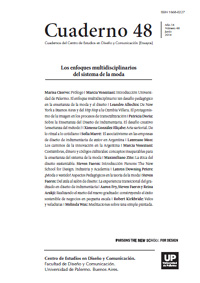Veils and velocities
Abstract
The bonds of fashion and the constructed environment are deep, tectonically and culturally. In medieval spiritual meditation, the mind was built in the image of a
walled city whose buildings were “clothed” by moral understanding; in Renaissance Florence, the philosopher-doctor Marsilio Ficino recommended that planetary colors be worn
and applied as architectural ornament to assist in contemplation and judgment. Linked
etymologically, our habits (abitudine), clothing (abito), and buildings (abitazione) are the
revealing ornaments of our minds, preparing us for everyday life. The array of artifacts and
accessories that extend from clothing to shelter furnishes the imagination with ingredients
for personal and shared memory and identity. This article will consider several historical
and contemporary examples.
References
(1988). On the Art of Building in Ten Books. Translated by Joseph Rykwert, Neil Leach, and Robert Tavernor. Cambridge, MA: The MIT Press.
Calvino, I. (1985). Mr. Palomar. Translated by William Weaver. New York: Harcourt Brace Jovanovich.
Carruthers, Mary. 1998. The Craft of Thought: Meditation, Rhetoric, and the Making of Ima- ges, 400–1200. Cambridge: Cambridge University Press.
Castiglione, B. (1929). The Book of the Courtier. Translated by Leonard Eckstein Opdycke.
New York: Horace Liveright.
Datta, S. (2010). Infinite Sequences in the Constructive Geometry of Tenth-Century Hindu Temple Superstructures. In Nexus Network Journal, Vol. 12 no. 3. Special issue edited by R. Kirkbride. Basel: Birkhäuser Verlag.
Evans, C. (2002). Fashion Stranger than Fiction: Shelley Fox. Interview in The Englishness of English Dress, edited by Christopher Breward. Oxford: Berg. pp. 189-208.
Ficino, M. (1980). Book of Life (Liber de vita or De vita triplici). Translated by Charles Boer.
Woodstock, CT: Spring.
Ginzburg, C. (1992). From Aby Warburg to E. H. Gombrich. In Clues, Myths, and the His- torical Method. Translated by John and Anne C. Tedeschi. Baltimore: Johns Hopkins University Press. pp. 17-59.
Holland, B. (2010). Computational Organicism: Examining Evolutionary Design Strategies in Architecture. In Nexus Network Journal, Vol. 12 no. 3. Special issue edited by R. Kirkbride. Basel: Birkhäuser Verlag.
Kirkbride, R. (2013). Rhetoric and Architecture. In The Oxford Handbook of Rhetorical Stu- dies. Edited by Michael MacDonald and A. McMurry. Oxford: Oxford University Press.
(2010). Geometries of Rhetoric. In Nexus Network Journal, Vol. 12 no. 3. Special issue edited by R. Kirkbride. Basel: Birkhäuser Verlag. http://www.nexusjournal.com/volume- 12/number-3--november-2010.html (2009). On Water and Development. In WATER: Alphabet City Vol. 14. Edited by John Knechtel. Cambridge, MA: The MIT Press. pp. 114-23.
(2008). Architecture and Memory: the Renaissance Studioli of Federico da Montefeltro. New York: Columbia University Press. http://www.gutenberg-e.org/kirkbride/ .
(2007). Mindmapping exercise. Produced by The Cooper Hewitt National Design Museum, from workshops during the 2006 Summer Design Institute: http://www.youtube.com/watch?v=62BuGge702k Lee, R. W. (1967). Ut pictura poesis: The Humanist Theory of Painting. New York: W. W. Norton.
Metraux, G. (1995). Sculptors and Physicians in Fifth-Century Greece. Montreal: McGill- Queen’s University Press.
Monk, T. (n/d). Transcribed by Steve Lacy. See blogpost of January 3, 2009: http:// 1heckofaguy.com/2009/01/03/thelonious-monks-advice-archived-by-steve-lacy/ Nexus Network Journal. (2012),Vol. 14 No. 3 . See especially Sheil’s “Manufacturing Bespo- ke Architecture,” Klinger’s “Design-Through-Production Formulations,” and Paio, Eloy, Rato, Resende and de Oliveira’s “Prototyping Vitruvius, New Challenges: Digital Education, Research and Practice”.
Onians, R. B. (1951). The Origins of European Thought. Cambridge: Cambridge University Press.
Padel, R. (1992). In and Out of the Mind. Princeton: Princeton University Press.
Perec, G. (1997). Species of Spaces. In Species of Spaces and Other Pieces. Edited and trans- lated by John Sturrock. New York: Penguin Books.
Petrarch, F. (2005). Letters on Familiar Matters, Vol. 3. Translated by Aldo Bernardo. New York: Italica Press.
Romanyshyn, R. (2008). The Despotic Eye. In Janus Head, Vol. 10 no. 2. Amherst, NY: Tri- vium Publications. pp. 505-27.
Ruskin, J. (1859). Elements of Perspective. London: Smith, Elder & Co.
Trilling, J. (2003). Ornament: A Modern Perspective. Seattle: University of Washington Press.
Van Eck, C. (2007). Classical Rhetoric and the Visual Arts in Early Modern Europe. Cam- bridge: Cambridge University Press.
Viemeister, T. (2001). Innovation, Vol. 20 no. 3 IDSA. pp. 38-41.
Vitruvius. De architectura. 1983. Translated by Frank Granger. Cambridge, MA: Harvard University Press.
Williams, K. (2012). Digital Fabrication. Nexus Network Journal. Vol. 14 No. 3. Basel: Birk- häuser Verlag.
Los autores/as que publiquen en esta revista ceden los derechos de autor y de publicación a "Cuadernos del Centro de Estudios de Diseño y Comunicación", Aceptando el registro de su trabajo bajo una licencia de atribución de Creative Commons, que permite a terceros utilizar lo publicado siempre que de el crédito pertinente a los autores y a esta revista.


